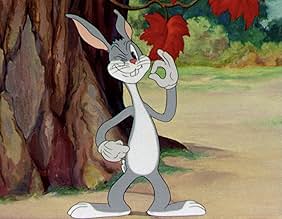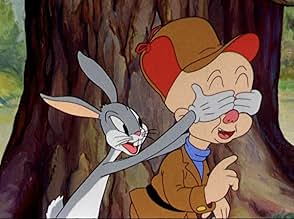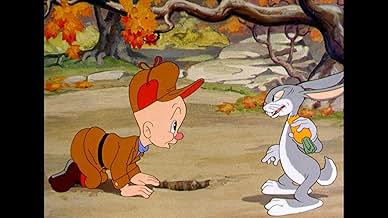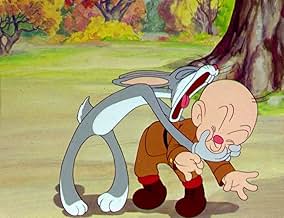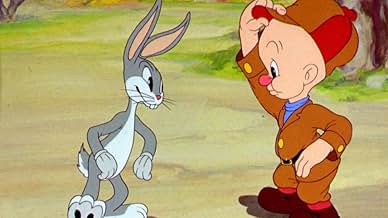VALUTAZIONE IMDb
7,7/10
2062
LA TUA VALUTAZIONE
Aggiungi una trama nella tua linguaWhile hunting rabbits, Elmer Fudd comes across Bugs Bunny, who tricks and harasses the hunter.While hunting rabbits, Elmer Fudd comes across Bugs Bunny, who tricks and harasses the hunter.While hunting rabbits, Elmer Fudd comes across Bugs Bunny, who tricks and harasses the hunter.
- Regia
- Sceneggiatura
- Star
- Candidato a 1 Oscar
- 2 candidature totali
Mel Blanc
- Bugs Bunny
- (voce)
- (non citato nei titoli originali)
- …
Arthur Q. Bryan
- Elmer Fudd
- (voce)
- (non citato nei titoli originali)
Recensioni in evidenza
This is my third favorite cartoon, only beat by Invasion of the Bunny Snatchers and Duck Amuck. It manages to feel newer than the shorts where Elmer is fat, due to having Elmer's final design. It also has value that makes this based, introducing Bugs.
Compared to the first (two) appearances of the developing Bugs, this is very funny, has characters with incredibly developed plots and indeed is better quality. I find because the humour of "Porky's Hare Hunt" and "Prest-O Change-O" are very old-fashioned and not very understandable for today's humour (although I still found "Porky's Hare Hunt" quite funny). This episode feels much more like it was made recently, even though it was made only two or three years after the developing Bug's first appearances. In this, apart from his deeper voice, he feels much more like the Bugs Bunny we know today.
I also like this episode for the very sweet first Elmer featured, Bugs Bunny is very entertaining and there is nice animation included. I have to say in this, Bugs Bunny reminded me a lot of Br'er Rabbit, which was comforting (HE didn't make his first appearance for nearly ten years after!!).
The plot is very much like the average episode with Elmer and Bugs. Elmer is hunting for "wabbits" and he finds Bugs. Many of the gags have been repeated many times in more recent episodes, but are still funny none the less. There are some other gags added which are funny.
I recommend this episode to enthusiasts of early Looney Tunes (but still like gags which are repeated in modern Looney Tunes episodes) and who like Bugs Bunny. Enjoy "A Wild Hare"!
I also like this episode for the very sweet first Elmer featured, Bugs Bunny is very entertaining and there is nice animation included. I have to say in this, Bugs Bunny reminded me a lot of Br'er Rabbit, which was comforting (HE didn't make his first appearance for nearly ten years after!!).
The plot is very much like the average episode with Elmer and Bugs. Elmer is hunting for "wabbits" and he finds Bugs. Many of the gags have been repeated many times in more recent episodes, but are still funny none the less. There are some other gags added which are funny.
I recommend this episode to enthusiasts of early Looney Tunes (but still like gags which are repeated in modern Looney Tunes episodes) and who like Bugs Bunny. Enjoy "A Wild Hare"!
A Wild Hare (1940)
*** 1/2 (out of 4)
This is where it all started as the dimwitted Elmer Fudd travels to the woods hunting rabbit and comes across Bugs Bunny who is just too smart. A WILD HARE was actually the third film that Bugs appeared in but this here is the official first as the rabbit we all love. It's funny watching this first short because what's here is what we'd see for the next several decades as Bugs was just so appealing and he was often put up against rather dumb characters. There are several very funny moments here but the highlight has to be poor Elmer not realizing that while his digging for the rabbit that he's actually sitting there talking to him. Another highlight is the scene where Bugs pretends to die just so he can pull one more prank.
*** 1/2 (out of 4)
This is where it all started as the dimwitted Elmer Fudd travels to the woods hunting rabbit and comes across Bugs Bunny who is just too smart. A WILD HARE was actually the third film that Bugs appeared in but this here is the official first as the rabbit we all love. It's funny watching this first short because what's here is what we'd see for the next several decades as Bugs was just so appealing and he was often put up against rather dumb characters. There are several very funny moments here but the highlight has to be poor Elmer not realizing that while his digging for the rabbit that he's actually sitting there talking to him. Another highlight is the scene where Bugs pretends to die just so he can pull one more prank.
It is very hard to review "A Wild Hare" on its own solo merit after the sixty-plus years that followed and thus turned its central character into the biggest cartoon character ever. In comparison to the subsequent films that appeared until 1964, this very first official entry is tame but still a wonderful model for those that followed.
Let's say this was 1940 and If I saw this cartoon for the first time ever with absolutely no knowledge of Bugs Bunny, I would say that "A Wild Hare" alone is a fine cartoon, in which the hunter becomes the heckled. The prey is a slick "wabbit" character that starts in on him at the very beginning, knocking on the wisping hunter's bald head to get his attention.
It is no wonder that this cartoon is directed by Fred Avery, who only three years ago directed a similar cartoon called "Porky's Duck Hunt," in which Porky's prey evolved into the current Looney Tunes star Daffy Duck. Should we be keeping our eyes on this "wabbit?"
Let's say this was 1940 and If I saw this cartoon for the first time ever with absolutely no knowledge of Bugs Bunny, I would say that "A Wild Hare" alone is a fine cartoon, in which the hunter becomes the heckled. The prey is a slick "wabbit" character that starts in on him at the very beginning, knocking on the wisping hunter's bald head to get his attention.
It is no wonder that this cartoon is directed by Fred Avery, who only three years ago directed a similar cartoon called "Porky's Duck Hunt," in which Porky's prey evolved into the current Looney Tunes star Daffy Duck. Should we be keeping our eyes on this "wabbit?"
Elmer and Bugs finally collide for real this time for the first time ever, in an excellent short by the late, great Tex Avery that hints of things to come. Elmer of course is hunting rabbits, Bugs(unnamed when this came out, although we all know it's him now) is of course defending himself, foiling Elmer's plans and driving him crazy. This is one of the two's best(why wasn't this on the Looney Tunes DVD? Oh well, guess I can wait for a Silver collection). I recommend seeing it to any fan of the "wabbit," or the hunter. After seeing how little has actually changed between the two, it's easy to realize that some things really do never change.
BOTTOM LINE: The first, and one of the best, Bugs vs. Elmer shorts.
BOTTOM LINE: The first, and one of the best, Bugs vs. Elmer shorts.
Lo sapevi?
- QuizThe producers' reaction to the gag of Bugs responding to a hunter pointing a gun at him with a confident casual remark, "What's up, Doc?" was so favorable that they decided to make that a standard element of future films featuring the character.
- BlooperAfter Bugs ties up Elmer's shotgun and Elmer throws it away he then starts digging. Bugs comes up from his other hole, saying his first time ever "Eh Whats up Doc?" then Elmer says "I am looking for a Wabbit". Bugs starts describing a rabbit and during a close up When Elmer realized Bugs is a rabbit he us holding the shotgun again, next panel it's gone again.
- Citazioni
[first lines]
Elmer Fudd: [first occurence of this line] Be vewy, vewy qwiet. I'm hunting wabbits.
- Curiosità sui creditiIn the 1944 Blue Ribbon reissue of this cartoon, when the WB shield zooms in the copyright notice briefly says MCMXLIV(1944) for a fraction of a second before changing to MCMXL(1940)!
- Versioni alternativeWhen the cartoon was re-released as a Blue Ribbon re-issue, it was inadvertently retitled "The Wild Hare." Also, one of the names Elmer Fudd guesses was changed from Carole Lombard, who had recently died in a plane crash, to Barbara Stanwyck.
- ConnessioniEdited into Bugs Bunny Superstar (1975)
- Colonne sonoreYankee Doodle
(ca. 1755) (uncredited)
Traditional music of English origin
I più visti
Accedi per valutare e creare un elenco di titoli salvati per ottenere consigli personalizzati
Dettagli
- Data di uscita
- Paese di origine
- Sito ufficiale
- Lingua
- Celebre anche come
- Conigli e carote
- Azienda produttrice
- Vedi altri crediti dell’azienda su IMDbPro
- Tempo di esecuzione
- 8min
- Mix di suoni
- Proporzioni
- 1.37 : 1
Contribuisci a questa pagina
Suggerisci una modifica o aggiungi i contenuti mancanti

